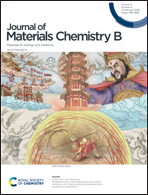Effect of the Sr–Fe layered double hydroxide coating based on the microenvironment response on implant osseointegration in osteoporotic rats†
Abstract
Osteoporosis is a disease that manifests itself as an abnormality of bone metabolism and is characterized by low bone mass and destruction of the bone microstructure. Since bone resorption occurs more rapidly than new bone formation, osteoporosis leads to reduced orthopedic implant stability. From a microenvironmental point of view, the rationale for this outcome is that osteoclasts are overactive in the bone tissue of patients with osteoporosis, and the large amount of H+ they produce leads to local chronic acidosis, which promotes bone mineral loss. Therefore, we designed a weakly alkaline layered double hydroxide (LDH) coating to modulate the pathologically acidic microenvironment and the osteogenic–osteoclastic coupling by releasing Sr2+. We prepared Sr–Fe LDH coatings on pure titanium implants using a hydrothermal method in this study and characterized the material using SEM, AFM, XRD, XPS, EDS, ICP, pH acidimeter, etc. We found that the coatings had good nanomorphology and were able to efficiently neutralize H+ as well as steadily release Sr2+ for up to 21 days. In vitro, the coating not only significantly promoted the adhesion, proliferation, and differentiation of osteoblasts, but also inhibited the differentiation of osteoclasts at the same time. In addition, in animal experiments, the coating significantly improved the mechanical stability of the implant in osteoporotic rats, increasing Sr–Fe LDH@Ti maximal push-out force by 72.2% compared to Ti. At the same time, the coating was effective in reversing the osteoporotic state, resulting in a 58.5% increase in BV/TV (%), and a 12.4% increase in Tb. N (1 mm−1), a 31.6% increase in Tb. Th (μm), and a 30.9% increase in BA (%). Our results suggest that this Sr–Fe LDH nanocoating material with acid-neutralizing, as well as long-term Sr2+-releasing capabilities, is a novel and effective orthopedic implant coating material under osteoporotic conditions.



 Please wait while we load your content...
Please wait while we load your content...